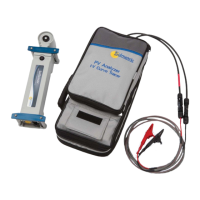6 Measuring Irradiance, Temperature, and Tilt
6-10
Determining Cell Temperature from the Measured I-V
Curve
When you select the From I-V option, the PVA software calculates the equivalent cell
temperature from the measured I-V curve. This option has several benefits and several
limitations, all due to the fact that since temperature is calculated mainly from the
measured V
oc
and the resulting temperature value is an input to the PV model, the model
dot representing V
oc
is forced to agree with the measured value of V
oc
.
The From I-V temperature option provides several benefits:
• The resulting temperature value represents the average cell temperature, which
is what the PV model needs. The method properly accounts for temperature
variation across the module or string under test.
• There is no time delay between measurement of the I-V curve and determination
of temperature. This is helpful when module temperature is changing rapidly, a
condition under which a time delay translates into a temperature error. Rapid
temperature changes can result from variable cloudiness and also from gusty
wind.
• Since the predicted V
oc
value (the right-hand red dot superimposed on the
displayed I-V curve) is forced to is forced to agree with the measured V
oc
value,
it is easier to notice any deviations between the shapes of the measured and
predicted I-V curves.
The From I-V temperature option also has certain limitations:
• The model by which temperature is determined from Voc is valid only at
relatively high irradiance. At low irradiance, there is substantial error in the
derivation of temperature.
• If the PV source under test has one or more shorted or conducting bypass
diodes, the software will calculate a lower-than-actual cell temperature. You
can mitigate this risk by comparing Voc values between strings or modules
under test. Values should be fairly consistent. If a single string shows a
deviation of more than about 10-12 volts, a bypass diode may be turned on or
shorted.
• The From I-V cell temperature value is used by the predictive PV model to
calculate the expected value of Voc. Using a measured value to calculate the
expected value is circular, forcing the expected value of Voc to agree with the
measured value.

